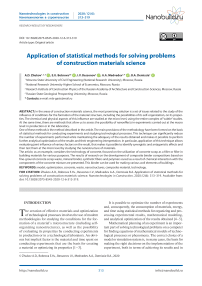Application of statistical methods for solving problems of construction materials science
Автор: Zhukov A.D., Bobrova E.Yu., Bessonov I.V., Medvedev A.A., Demissie B.A.
Журнал: Nanotechnologies in Construction: A Scientific Internet-Journal @nanobuild-en
Рубрика: Research results of researchers
Статья в выпуске: 6 Vol.12, 2020 года.
Бесплатный доступ
In the areas of construction materials science, the most promising solution is a set of issues related to the study of the influence of conditions for the formation of the material structure, including the possibilities of its self-organization, on its properties. The chemical and physical aspects of this influence are studied at the micro level, using the entire complex of “subtle” studies. At the same time, there are methods that allow us to assess the possibility of nanoeffects in experiments carried out at the macro level: in production or in the laboratory. One of these methods is the method described in the article. The main provisions of the methodology have been formed on the basis of statistical methods for conducting experiments and studying technological processes. This technique can significantly reduce the number of experiments performed while maintaining the adequacy of the results obtained and makes it possible to perform further analytical optimization of the results and their engineering interpretation. In particular, application of this technique allows evaluating joint influence of various factors on the result, that makes it possible to identify synergistic and antagonistic effects and then test them at the micro level by studying the nanostructure of materials. The article, as an example, considers the technology of concrete, focused on the utilization of concrete scrap as a filler or filler in building materials for various purposes. The results of research on the development of composite binder compositions based on fine-ground concrete scrap waste, mineral binder, synthetic fibers and polymers cured as a result of chemical interaction with the components of the concrete mixture are presented. This binder can be used for making various wall elements of buildings.
Model, optimization, concrete, waste, nanostructures, composite material, technology
Короткий адрес: https://sciup.org/142226941
IDR: 142226941 | DOI: 10.15828/2075-8545-2020-12-6-313-319
Список литературы Application of statistical methods for solving problems of construction materials science
- Adler Yu.P.,Markova E.V., Granovsky Yu.V. Experiment planning in the search for optimal conditions. 2nd ed. Moscow: Nauka, 1976.
- Voznesensky V.A. Statistical methods of experiment planning in technical and economic research. Moscow: Finance and statistics, 1981.
- Rumyantsev B.M., Zhukov A.D. Experiment and modeling in the creation of new insulation and finishing materials. Moscow: Moscow state University of civil engineering, EBS ASV, 2013. Available from: http://www.iprbookshop.ru/23755. EBS ≪IPRbooks≫, by password ISBN: 978-5-7264-0700-5.
- Zhukov A.D., Chugunkov A.V. Local analytical optimization of technological processes.MGSU Bulletin. 2011;1-2: 273-278.
- Shannon R. System simulation is an art and science. Moscow: Mir, 1982.
- Zhukov A.D. Technological modeling. Moscow: Moscow state University of civil engineering, EBS ASV; 2013. Available from: http://www.iprbookshop.ru/20041. EBS ≪IPRbooks≫, by password ISBN: 978-5-7264-0780-7.
- Hartman K., Hartman K., Leptsky E., Schaefer V. Planning an experiment in research of technological processes. Moscow: Mir, 1977.
- Zhukov A.D.,Chugunkov A.V., Rudnitskaya V.A. Solution of technological problems by methods of mathematical modeling. Moscow: MGSU, 2011.
- Pisarenko J.V., Ivanov L.A., Wang C. Nanotechnology in construction: present state and development trends. Nanotechnology in construction. 2020; 12(4): 223-231. Available from doi: 10.15828/2075-8545-2020-12-4-223-231.
- Sanchez F., Sobolev K. Nanotechnology in concrete – A review. Construction and Building Materials. 2010; 24: 2060–2071. Available from doi: 10.1016/j.conbuildmat.2010.03.014.
- Velichko, E., Shokodko, E. Reactive powder concrete based on multicomponent cement sys-tems with multilevel optimization of the disperse composition. MATEC Web of Conferences. 2018; 251: article number 01042. Available from doi: 10.1051/matecconf/201825101042.
- Murtazaev S.-A.Yu., Bata D.K.-S., Ismailov Z.H., Murtazaev S.-Y.A. Fine-grained concrete on the basis of the fillers from recycled materials. Moscow: Komtekhprint, 2017.
- Bags P.I., Mokin, V.A. Methods of optimization of compositions of dry building mixes. Building materials. 2000;5: 12-14.
- Zhukov A.D., Smirnova T.V., Gudkov P.K. Practicum on technological modeling. Moscow: Moscow state University of civil engineering, EBS DIA; 2014. Available from: http://www.iprbookshop.ru/30351. – EBS ≪IPRbooks≫, by password ISBN: 978-5-7264-0903-0.
- Zhukov A., Shokodko E., Bobrova E., Bessonov I., Dosanova G., Ushakov N. Interior Acoustic Materials and Systems.EMMFT-2018. Advances in Intelligent Systems and Computing. 2019; 983: 740-747. Available from doi: 10.1007/978-3-030-19868-8_72.
- Efimenko A.Z., Pilipenko A.S. Obtaining decorative finishing materials for facade systems on aggregates from concrete waste. MGSU Bulletin. 2009; Special issue: 100-103.
- Gorbunov G.I., Zhukov A.D. Scientific bases of formation of structure and properties of building materials. Moscow: Moscow State University of Civil Engineering, AI PI er Media, EBS ASV; 2016. Available from: http://www.iprbookshop.ru/49870. EBS ≪IPRbooks≫, by password ISBN: 978-5-7264-1318-1.
- Zhukov A., Shokodko E. Mathematical Methods for Optimizing the Technologies of Build-ing Materials. VIII International Scientific Siberian Transport Forum. TransSiberia 2019. Advances in Intelligent Systems and Computing. 2020;1116: 413-421. Available from doi: 10.1007/978-3-030-37919-3_40.
- Bessonov I., Zhukov A., Shokodko E., Chernov A. Optimization of the technology for the pro-duction of foam glass aggregate. TPACEE 2019. E3S Web of Conferences, 2020. 164: article number 14016. Available from doi: 10.1051/e3sconf/202016414016.


